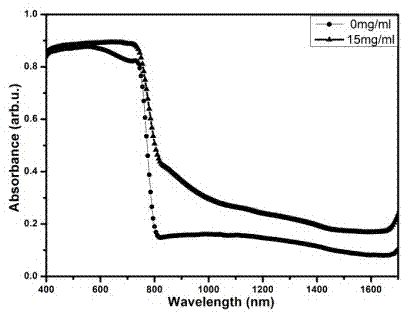Preparation of organic-inorganic composite solar cell based on perovskite-nano germanium particles
A solar cell, inorganic composite technology, applied in circuits, photovoltaic power generation, electrical components, etc., can solve the problem of perovskite solar cells' poor long-wavelength light absorption coefficient capability, inability to effectively absorb and utilize long-wavelength sunlight, and inability to guarantee successful performance. The large-area uniformity of the film can be improved to improve the carrier transport capacity, realize large-scale industrial production, and improve the long-wave response range.
- Summary
- Abstract
- Description
- Claims
- Application Information
AI Technical Summary
Problems solved by technology
Method used
Image
Examples
Embodiment Construction
[0018] Such as figure 1 As shown, it is a schematic diagram of the battery structure obtained based on the preparation method of the perovskite-nano germanium particle organic-inorganic composite solar cell in the specific embodiment of the present invention, and the solar cell includes:
[0019] (1) Fluorine-doped tin dioxide (FTO) conductive glass 1;
[0020] (2) TiO 2 The electron transport layer 3 is spin-coated on the FTO conductive glass 1;
[0021] (3) Perovskite-nano-germanium particle composite active layer 4, ultrasonically sprayed on TiO 2 On the electron transport layer 3;
[0022] (4) P3HT organic polymer hole transport layer 5, spin-coated on the perovskite-nano-germanium particle composite active layer 4;
[0023] (5) The metal electrodes 2 and 6 are deposited on the FTO conductive glass 1 and the hole transport layer 5 respectively.
[0024] The specific preparation and preparation process of an organic-inorganic composite solar cell device based on perovs...
PUM
| Property | Measurement | Unit |
|---|---|---|
| Diameter | aaaaa | aaaaa |
| Thickness | aaaaa | aaaaa |
| Thickness | aaaaa | aaaaa |
Abstract
Description
Claims
Application Information
 Login to View More
Login to View More - R&D
- Intellectual Property
- Life Sciences
- Materials
- Tech Scout
- Unparalleled Data Quality
- Higher Quality Content
- 60% Fewer Hallucinations
Browse by: Latest US Patents, China's latest patents, Technical Efficacy Thesaurus, Application Domain, Technology Topic, Popular Technical Reports.
© 2025 PatSnap. All rights reserved.Legal|Privacy policy|Modern Slavery Act Transparency Statement|Sitemap|About US| Contact US: help@patsnap.com



